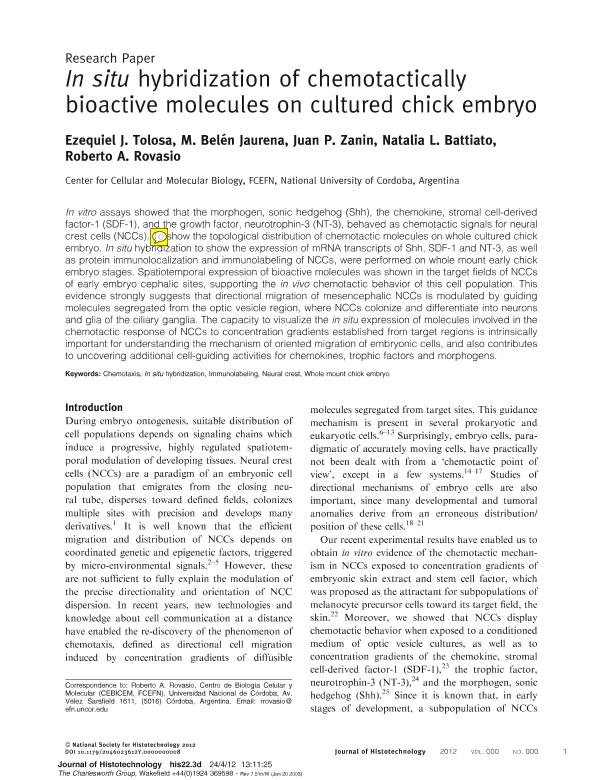Artículo
In situ hybridization of chemotactically bioactive molecules on whole mounted chick embryo
Tolosa, Ezequiel Julian ; Jaurena, María Belén
; Jaurena, María Belén ; Zanin, Juan Pablo
; Zanin, Juan Pablo ; Battiato, Natalia Laura; Rovasio, Roberto Americo
; Battiato, Natalia Laura; Rovasio, Roberto Americo
 ; Jaurena, María Belén
; Jaurena, María Belén ; Zanin, Juan Pablo
; Zanin, Juan Pablo ; Battiato, Natalia Laura; Rovasio, Roberto Americo
; Battiato, Natalia Laura; Rovasio, Roberto Americo
Fecha de publicación:
05/2012
Editorial:
Maney Publishing
Revista:
Journal Of Histotechnology
ISSN:
0147-8885
e-ISSN:
2046-0236
Idioma:
Inglés
Tipo de recurso:
Artículo publicado
Clasificación temática:
Resumen
In vitro assays showed that the morphogen, sonic hedgehog (Shh), the chemokine, stromal cell-derived factor-1 (SDF-1), and the growth factor, neurotrophin-3 (NT-3), behaved as chemotactic signals for neural crest cells (NCCs) and are associated with a topological distribution of chemotactic molecules on whole cultured chick embryo. In situ hybridization was conducted to show the expression of mRNA transcripts of Shh, SDF-1 and NT-3, while protein immunolocalization and immunolabeling of NCCs were performed on whole mount early chick embryo stages. Spatiotemporal expression of bioactive molecules was shown in the target fields of NCCs of early embryo cephalic sites, supporting the in vivo chemotactic behavior of this cell population. This evidence strongly suggests that directional migration of mesencephalic NCCs is modulated by guiding molecules segregated from the optic vesicle region, where NCCs colonize and differentiate into neurons and glia of the ciliary ganglia. The capacity to visualize the in situ expression of molecules involved in the chemotactic response of NCCs to concentration gradients established from target regions is intrinsically important for understanding the mechanism of oriented migration of embryonic cells, and also contributes to uncovering additional cell-guiding activities for chemokines, trophic factors and morphogens.
Archivos asociados
Licencia
Identificadores
Colecciones
Articulos(IIBYT)
Articulos de INSTITUTO DE INVESTIGACIONES BIOLOGICAS Y TECNOLOGICAS
Articulos de INSTITUTO DE INVESTIGACIONES BIOLOGICAS Y TECNOLOGICAS
Citación
Tolosa, Ezequiel Julian; Jaurena, María Belén; Zanin, Juan Pablo; Battiato, Natalia Laura; Rovasio, Roberto Americo; In situ hybridization of chemotactically bioactive molecules on whole mounted chick embryo; Maney Publishing; Journal Of Histotechnology; 35; 3; 5-2012; 114-129
Compartir
Altmétricas



